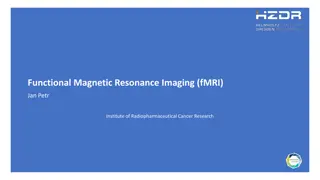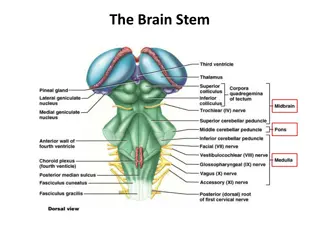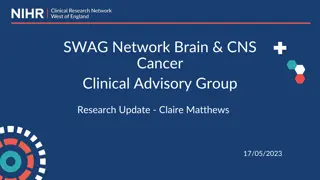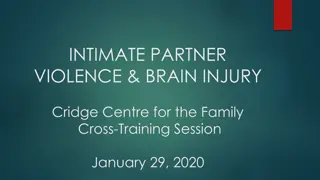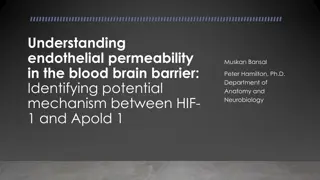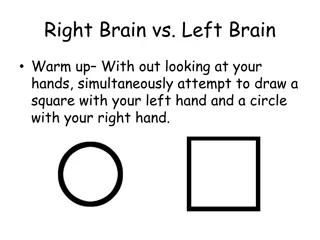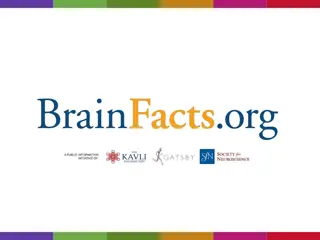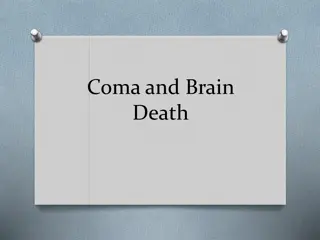Brain Research Insights on Teaching Methods
Explore brain lateralization and dominance, highlighting how the right and left hemispheres influence skills and functions. Understand the general diagram of brain functions and debunk the myth of being solely right-brained or left-brained. Embrace VAK Learning Styles to cater to diverse learning preferences and enhance teaching effectiveness.
Download Presentation

Please find below an Image/Link to download the presentation.
The content on the website is provided AS IS for your information and personal use only. It may not be sold, licensed, or shared on other websites without obtaining consent from the author. Download presentation by click this link. If you encounter any issues during the download, it is possible that the publisher has removed the file from their server.
E N D
Presentation Transcript
BRAIN RESEARCH INFORMATION RELATED TO TEACHING METHODS Updated 4-22-20 Karen Baranoski Wilkes Science in Motion
Brain Lateralization/Dominance Brain Lateralization: refers to the idea that the right and left sides of the brain are specialized for certain skills, representing a basic principle of the brain s organization (Mitchell, G.) This information has come from studies of patients with brain injuries, illnesses, and congenital deformities, and more recently brain imaging techniques such as PET scans. Both cerebral hemispheres participate in basic functions. However, one side usually acts as a dominant hemisphere for certain other functions. In most persons, the left hemisphere is dominant for the language-related activities of speech, writing, and reading; also for complex intellectual functions requiring verbal, analytical, and computational (math) skills (Shier D. et. al 2007).
Brain Lateralization/Dominance 2 Right hemisphere has been attributed to controlling the left side of the body, motor tasks that require orientation of body in space, understanding musical patterns, and visual experiences. It also provided emotional and intuitive thought processes. Tests indicate the left hemisphere is dominant in 90% of right-handed adults, and 64% of left handed ones. A smaller % of both right (10%) and left (20%) handed adults have right hemisphere dominance; the hemispheres are equally dominant in 16% of left handed persons (Shier, D. 2007). Despite the fact that there is division of tasks in the brain, there is not a complete separation into left or right, both sides are almost always involved in any given task and in constant communication(Mitchell, G.)
Brain Lateralization 3 Pop psychology overgeneralizes this idea to suggest that different people are defined as right-or-left-brained (like saying someone musically oriented is right-brained or someone who is a rational scientist is left- brained). While some research does suggest these generalizations are somewhat supported by brain activity measures, it does not mean that a certain thinking style lies solely within each hemisphere (Mitchell, G.) One popular example is Betty Edwards' Drawing on the Right Side of the Brain, first published in 1979 but now in its fourth edition (2012), which epitomizes the popular view that the right hemisphere is responsible for creativity. However, brain imaging shows creative thought activates a wide neuronal network favoring neither hemisphere (Ellamil.M et.al. 2010). Rather than using terms such as right or left brained, a teacher in the classroom should be aware of differences in personalities and learning styles and prepare lessons for all students using a variety of modalities for as many lessons as possible.
VAK Learning Styles The VAK Learning Styles Model was developed by psychologists in the 1920s to classify the most common ways that people learn. According to the model, most of us prefer to learn in one of three ways: visual, auditory or kinesthetic (although, in practice, we generally "mix and match" these three styles) Visual: a visually-dominant learner absorbs and retains information better when it is presented in, for example, pictures, diagrams and charts. Auditory: an auditory-dominant learner prefers listening to what is being presented. He or she responds best to voices, for example, in a lecture or group discussion. Hearing his own voice repeating something back to a tutor or trainer is also helpful. Kinesthetic: a kinesthetic-dominant learner prefers a physical experience. He or she likes a "hands-on" approach and responds well to being able to touch or feel an object or learning prop (Mind Tools 2020).
VAK Learning Styles (Page 2) It is helpful for a person to become aware of his or her individual style to help achieve maximum potential with minimum frustration. A basic, quick version of a VAK test is available on the SIM Website- online resources section that might be useful for student from middle through high school grades https://www.businessballs.com/freepdfmaterials /vak_learning_styles_questionnaire.pdf
Basic Neuron with Synapse(Quizlet.com)
Neuron Important Terms(Shier 2007) Dendrite small cellular processes that receive the input Cell body contains the nucleus Axon usually a longer process that carries the impulse away from the cell (Nerves are bundles of axons) Nerve impulse bioelectric signals Synapse (synaptic cleft) the gap between neurons where communication occurs Axon terminals (end bulbs) hold and release neurotransmitters Neurotransmitter a chemical that an axon end secretes to stimulate a muscle fiber to contract, gland to secrete, or neuron to fire an impulse Myelin sheath fatty material that forms a covering around some axons Nodes of Ranvier short regions of exposed axons in neurons in the PNS- help impulse move faster
Learning/Memory Learning vs memory: Learning is the acquisition of new knowledge, memory is the persistence of that knowledge, being able to access it at a later time (Shier 2007). Short Term Memory lasts only seconds or hours and is the ability to recall bits of information. One theory states that memories may be cause by reverberating neuronal circuits neurons in chain keep stimulating each other again and again. The signal may last for a few seconds up to a few hours. Evidence supports this depends on electrical and chemical events in the brain rather than structural changes (Tortora & Grabowski 1993). Long Term Memory lasts from days to years. Most research focuses on anatomical or biochemical that might enhance facilitation at synapses. Presynaptic neurons subjected to prolonged, intense activity show an increase in the number of terminals, enlargement of end bulbs, increases in branching patterns of dendrites , ability for faster action(Tortora & Grabowski 1993).
Relating Nerve Physiology to Learning With repeating tasks such as reading, hitting a baseball, playing video games, etc. nerve impulses travel faster along synapses, end bulbs with neurotransmitters get bigger, and anatomical changes occur in the nervous system. For most people without brain injuries or illnesses, learning becomes more successful with repeating/practicing the same things. Memory consolidation is reinforcement due to the frequent retrieval of a piece of information.
Learning and Memory Practicing/repeating tasks changes areas of the brain. Madelyn Hunter has espoused practicing at least 8 times to learn something, when something has been learned incorrectly it takes much more- about 28 times- 20 times to unlearn and relearn, and then 8 to remember the correct items (Reviewed in Wong & Wong 2003). Another important structure is the hippocampus, a part of the brain that controls memory and emotions (Tortora & Grabowski 2003). Due to these interconnections we remember emotional, dramatic events or experiences (good and bad). It is also associated with the sense of smell, which may help explain the success of the perfume industry. So it is important to make classroom experiences positive, exciting, emotional, stimulating so students might better remember what has been taught.
Importance of Lifelong Learning for Everyone Although some neurons are lost and age related changes occur- studies show that connections among synapses are continually made throughout a person s lifetime. This especially occurs if the person keeps active physically and mentally with crossword puzzles, social stimulation, enrichment classes, etc. According to HHS Guidelines: Preschool-aged children (ages 3 through 5 years) should be physically active throughout the day to enhance growth and development. Adult caregivers of preschool-aged children should encourage active play that includes a variety of activity types.
Activity Guidelines It is important to provide young people opportunities and encouragement to participate in physical activities that are appropriate for their age, that are enjoyable, and that offer variety. Children and Adolescents Children and adolescents ages 6 through 17 years should do 60 minutes (1 hour) or more of moderate-to-vigorous physical activity daily: Aerobic: Most of the 60 minutes or more per day should be either moderate- or vigorous-intensity aerobic physical activity and should include vigorous-intensity physical activity on at least 3 days a week. Muscle-strengthening: As part of their 60 minutes or more of daily physical activity, children and adolescents should include muscle- strengthening physical activity on at least 3 days a week. Bone-strengthening: As part of their 60 minutes or more of daily physical activity, children and adolescents should include bone-strengthening physical activity on at least 3 days a week.
Adult Exercise In 2008 the U.S. Department of Health and Human services updated its physical activity guidelines and recommends that: All adults should perform at least 150 minutes of moderate- intensity physical activity or 75 minutes of vigorous-intensity physical activity or an equivalent combination of moderate and vigorous-intensity aerobic activity, spread throughout the week. A person s nervous and cardiovascular system work together to keep a person healthy and active.
References Baranoski K (2020) Updated PowerPoint from Ed 371 (2015) Wilkes University, Wilkes-Barre, PA Corballis M (2014) Left brain, right brain: facts and fantasies Reviewed at PLOS Biology [Internet 22 April 20] https://www.ncbi.nlm.nih.gov/pmc/articles/PMC3897366/ Edwards.B (2012) Drawing on the right side of the brain. New York: Penguin Putnam. Cited in NIH article. Ellamail M, Dobson C, Beeman M, Christoff K (2012) Evaluative and generative modes of thought during the creative process. Neuroimage 59:1783-1794 [PubMed). Cited in NIH article HHS releases physical activity guidelines for Americans 2ndEdition (2018) https://www.hhs.gov/about/news/2018/11/12/hhs-releases-physical-activity-guidelines- americans-2nd-edition.html Hunter, M (1982) Mastery Teaching, El Sequndo, CA , reviewed Madeline Hunter model of mastery learning [Internet 22 April 2020] https://www.itma.vt.edu/courses/crmgmt2/resources/Hunter_Article.pdf MindTools VAK learning styles [Internet 22 April 2020] https://www.mindtools.com/pages/article/vak-learning-styles.htm Mitchell. G Definition of lateralization [Internet 22 April 2020] https://study.com/academy/lesson/brain-lateralization-function-definition-test.html
References 2 Quizlet by KimmyBlueVortex [Internet 22 April 2020] https://quizlet.com/366720382/labeling-the-neuron- diagram/ (Neuron diagram) Shier D, Butler J, Lewis R (2007) Hole s human anatomy & physiology 7thEd McGraw Hill, Boston MA Tortora G & Grabowski S (1993) Principles of Anatomy & Physiology 7thEd Harper Collins: NY VAK learning styles questionnaire [Internet 22 April 2020] https://www.businessballs.com/freepdfmaterials/vak_lea rning_styles_questionnaire.pdf
Reference 3 Wikipedia, Brain lateralization diagram [Internet 22 April 2020] https://commons.wikimedia.org/wiki/File:Brai n_Lateralization.svg Wong, H, Wong R (2009) The first days of school Harry Wong Publications, Inc. Mountain View, CA


